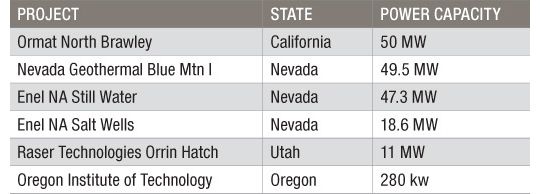2009 was a year of highs and some lows for the geothermal energy sector. What follows is a brief rundown of the year and the industry.
Facts and figures from this article come from the Geothermal Energy Association and the California Energy Commission.
New Projects in 2009
Six new geothermal plants came online in the U.S. in 2009 and more than 100 are under development. That's a potential of 10 gigawatts of geothermal power coming online in the next decade. Here is a list of the six new projects:

Source: GEA
-
Where Will DOE’s Loan Program Make the Next Climate Tech Investments?
48
-
What the Frack Is Happening With Natural Gas Prices?
15
-
With an Energy Crisis Brewing, No Peak in Sight for Emissions
9
The total online capacity of geothermal power in the U.S. was 3,152 megawatts as of August 2009 with about 2,600 megawatts in California and 448 megawatts in Nevada. Those two states will continue to dominate the geothermal landscape for the foreseeable future.
California Uber Alles
While solar and wind get all the headlines, geothermal quietly produced 4.5 percent of California’s total system power in 2007 with more than 40 operating geothermal plants in the state. U.S. geothermal installed capacity remains concentrated in California. In 2005, California’s geothermal power capacity was more than that of every country in the world.
The New Drivers for Geothermal
- Federal tax credits – the Production Tax Credit (PTC) for geothermal was extended to 2013 and the 30% Investment Tax Credit (ITC) was available as a cash grant.
- State Renewable Portfolio Standards – with California’s RPS at 33 percent by 2020 and Nevada at 25% by 2025, utilities in these two states are going to rely on geothermal to meet the RPS.
- R&D dollars from the DOE in 2009 are driving the continued focus on this renewable energy source in the form of loan guarantees and grants.
Dollars for Geothermal and Enhanced Geothermal
In 2009, as part of the ARRA stimulus, $400 million was appropriated for the DOE Geothermal Technologies Program with over 100 geothermal projects in 39 states. Recipients include private firms, academia, local governments and National Labs.
In 2009, The DOE invested more than $5 million into a demo project for the Enhanced Geothermal Systems plant operated by Ormat at Desert Peak, Nevada.The DOE has also selected other EGS projects for federal funding.
Enhanced Geothermal Systems (EGS) do not rely on naturally occurring reservoirs of hot water. Instead, EGS technology attempts to create geothermal resources by pumping high-pressure cold water into injection wells and then harvesting the heated water.
Even venture capital investors have started cautiously funding geothermal companies in 2009 with more than $35 million invested in two companies building geothermal heat pumps – EnLink and Nobao.
This focus on geothermal and the serious dollars channeled towards this technology is an important and new shift for the DOE and venture capital.
Some Bad News – Whole Lotta Shaking Going On
Venture Capitalists are used to technology risk, market risk, and policy risk. However they are not accustomed to seismic risk and the possible threat of eathquakes has shut down a project by VC-funded AltaRock.
In September of this year AltaRock’s EGS demo at The Geysers in Northern California suspended its drilling operations due, not to seismic activity, but to the bore-hole collapsing due to unstable geologies. Previous permitting studies had not indicated a problem. AltaRock continues to go after EGS, just not at The Geysers. AltaRock is funded by Google, Khosla Ventures, KPCB, ATV and Vulcan Capital.
But add that PR gaffe to the $9 million in damages caused by the actual seismic activity from the EGS project in Basel, Switzerland and EGS boosters are going to have move a little slower and more carefully in 2010.
Industry Players
Ormat is considered the leading pure-play geothermal firm. Competitors include U.S. Geothermal, Nevada Geothermal Power, Polaris Geothermal, Geothermal Resources, Calpine and Chevron Texaco.
Outlook for Geothermal in the Next Decade
- Geothermal will become more visible and accepted as a baseload power source.
- Carbon and climate change legislation will exert pressure for geothermal policy support by federal and state politicians.
- More private equity will flow into this space.
- Ambitious state Renewable Portfolio Standards in Nevada and California will continue the flood of projects in those states. The number of states with active geothermal power will increase to include Arizona, Alaska, Idaho, Hawaii, Wyoming, New Mexico, Louisiana, Mississipi, Oregon, and Utah.
- New technology will improve the efficiency and power potential of geothermal resources.

